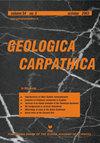地质数据、断层滑动分析和古应力重建揭示的穆拉松断层的结构模式和构造演化(西喀尔巴阡山)
IF 1.5
4区 地球科学
Q4 GEOSCIENCES, MULTIDISCIPLINARY
引用次数: 0
摘要
Muráň断层可能是喀尔巴阡山脉西部最独特、倾斜陡峭、易碎的构造。利用古应力张量对Muráň断裂进行脆性变形分析,获得了断裂的构造演化序列。该断层的移动取决于代表古应力场的主古应力轴的空间方向。断层滑动数据的运动学分析证实了该断层在整个历史中主要的走滑性质,有时被静止期或正常断层打断。Muráň断裂可能有85 Ma的历史,起源于地壳深处的韧性剪切带。在白垩纪晚期至古新世早期,可以认为Muráň断裂是左旋走滑断层。这一时期,在古应力场方向确定的情况下,断裂形成为半脆-脆性剪切带。古应力场的一次重大重组发生在古新世和始新世交界。在此变形过程中,Muráň断裂向右旋运动,中生代次生正、负花构造也极有可能在此时期形成。这些构造形成于大年纪之后,戈索群的沉积物被合并在这些构造中。晚始新世Muráň断裂活动逐渐减弱,断裂结构或多或少被中喀尔巴阡盆地始新统上海侵沉积所覆盖。新近纪演化的特征是最大主轴σ1 (SHmax)的方向由NW-SE向N-S向NE-SW方向连续变化。Muráň断层开始由左旋转张拉变为正断层,但沿断层的运动只有几十米。第四纪为西北西-东西方向上主最小轴σ3取向的伸展构造体系。钻孔分析表明,Rimava河和Muráň河冲积面存在晚更新世至全新世的正断层。本文章由计算机程序翻译,如有差异,请以英文原文为准。
The structural pattern and tectonic evolution of the Muráň fault revealed by geological data, fault-slip analysis, and paleostress reconstruction (Western Carpathians)
The Muráň fault is perhaps the most distinctive, steeply-dipping, brittle structure in the Western Carpathians. An analysis of brittle deformation was used to gain the succession of tectonic evolution of the Muráň fault by paleostress tensors. Movement on this fault depended on spatial orientation of the principal paleostress axes representing the paleostress fields. The kinematic analysis of fault-slip data confirmed the predominant strike-slip nature of the fault during the entire history, which had sometimes been disrupted by quiescence periods or normal faulting. The Muráň fault may be as old as 85 Ma and originated as a ductile shear zone in deeper crust. It is possible to consider the Muráň fault as sinistral transpressional strike-slip fault during the latest Cretaceous to earliest Paleocene. During this time period, with given orientation of the paleostress field, the fault originated as a semi-brittle to brittle shear zone. A significant re-organization of the paleostress field was carried out approximately on the boundary of the Paleocene and Eocene periods. During this deformation, movement on the Muráň fault changed to dextral, and the secondary positive and negative flower structures in Mesozoic rocks were most likely formed in this time as well. These structures originated after the Danian, since sediments of the Gosau Group are incorporated into these structures. In the late Eocene, activity of the Muráň fault gradually began to decrease, and the fault structure is more or less covered by the upper Eocene transgressive deposits of the Central Carpathian Paleogene Basin. The Neogene evolution is characterised by a continuous change of the orientation of the principal maximum axis σ1 (SHmax, respectively) from the NW–SE through N–S to NE–SW position. The Muráň fault started to become sinistral transpressional to transtensional up to a normal fault, however, the movement along the fault was only several tens of metres. The Quaternary period is characterised by an extensional tectonic regime with the orientation of principal least axis σ3 in the WNW–ESE direction. Late Pleistocene to Holocene normal faulting is indicated by borehole analysis in the alluvial planes of the Rimava and Muráň rivers.
求助全文
通过发布文献求助,成功后即可免费获取论文全文。
去求助
来源期刊

Geologica Carpathica
地学-地球科学综合
CiteScore
2.40
自引率
23.10%
发文量
26
审稿时长
>12 weeks
期刊介绍:
GEOLOGICA CARPATHICA covers a wide spectrum of geological disciplines including geodynamics, tectonics and structural geology, volcanology, stratigraphy, geochronology and isotopic geology, karstology, geochemistry, mineralogy, petrology, lithology and sedimentology, paleogeography, paleoecology, paleobiology and paleontology, paleomagnetism, magnetostratigraphy and other branches of applied geophysics, economic and environmental geology, experimental and theoretical geoscientific studies. Geologica Carpathica , with its 60 year old tradition, presents high-quality research papers devoted to all aspects not only of the Alpine-Carpathian-Balkanian geoscience but also with adjacent regions originated from the Mediterranean Tethys and its continental foreland. Geologica Carpathica is an Official Journal of the Carpathian-Balkan Geological Association.
 求助内容:
求助内容: 应助结果提醒方式:
应助结果提醒方式:


